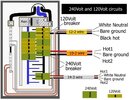I have the trench dug and the wire ran under and into the house. I have the wire laid in the trench up to the shop. It'll sit like that until I decide where to mount the breaker box and punch a hole in the wall for the wire.
I was advised to use a 50A breaker in the house, a 40A main breaker in the box in the shop, and as many 20A breakers as I want circuits. Sounds reasonable. I also had help picking out the components this morning. The problem I have right now, is I was advised to get a box with a main breaker, or that would accept one, and the one picked out has a 100A main. When I unboxed the breaker panel, I noticed the 100A breaker looked different and mounted differently. I asked about this (through text) and was told swap the 100 out with the 40. But, it can't be done. The 100 bolts on and is shaped differently than the 40. It's not a clean swap.
My question is, is there any danger in using the box with the 100A main if the conductors are coming from a 50A breaker in the house? If that is a problem, what options do I have? I haven't run across a box, yet, that has a spot to use a regular 40A breaker as the main.
I was advised to use a 50A breaker in the house, a 40A main breaker in the box in the shop, and as many 20A breakers as I want circuits. Sounds reasonable. I also had help picking out the components this morning. The problem I have right now, is I was advised to get a box with a main breaker, or that would accept one, and the one picked out has a 100A main. When I unboxed the breaker panel, I noticed the 100A breaker looked different and mounted differently. I asked about this (through text) and was told swap the 100 out with the 40. But, it can't be done. The 100 bolts on and is shaped differently than the 40. It's not a clean swap.
My question is, is there any danger in using the box with the 100A main if the conductors are coming from a 50A breaker in the house? If that is a problem, what options do I have? I haven't run across a box, yet, that has a spot to use a regular 40A breaker as the main.




